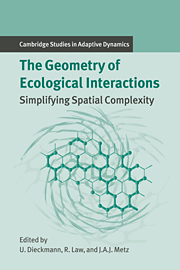Book contents
- Frontmatter
- Contents
- Contributing Authors
- 1 Introduction
- Part A Empirical and Statistical Background: A Plant Ecological Perspective
- Part B When the Mean-field Approximation Breaks Down
- Introduction to Part B
- 6 Grid-based Models as Tools for Ecological Research
- 7 Coexistence of Replicators in Prebiotic Evolution
- 8 Games on Grids
- 9 The Interplay between Reaction and Diffusion
- 10 Spirals and Spots: Novel Evolutionary Phenomena through Spatial Self-structuring
- 11 The Role of Space in Reducing Predator–Prey Cycles
- Part C Simplifying Spatial Complexity: Examples
- Part D Simplifying Spatial Complexity: Techniques
- References
- Index
- International Institute for Applied Systems Analysis
9 - The Interplay between Reaction and Diffusion
Published online by Cambridge University Press: 14 January 2010
- Frontmatter
- Contents
- Contributing Authors
- 1 Introduction
- Part A Empirical and Statistical Background: A Plant Ecological Perspective
- Part B When the Mean-field Approximation Breaks Down
- Introduction to Part B
- 6 Grid-based Models as Tools for Ecological Research
- 7 Coexistence of Replicators in Prebiotic Evolution
- 8 Games on Grids
- 9 The Interplay between Reaction and Diffusion
- 10 Spirals and Spots: Novel Evolutionary Phenomena through Spatial Self-structuring
- 11 The Role of Space in Reducing Predator–Prey Cycles
- Part C Simplifying Spatial Complexity: Examples
- Part D Simplifying Spatial Complexity: Techniques
- References
- Index
- International Institute for Applied Systems Analysis
Summary
Introduction
A large variety of spatio-temporal patterns can be observed in so-called reaction-diffusion systems: these systems model several different species that can interact with (“react to”) each other and diffuse in space. Such patterns, which depend on assumptions regarding the reaction and diffusion mechanisms, may be stationary or may change with time. The emerging patterns are often of great importance in both determining and understanding the properties of spatio-temporal dynamics.
Reaction-diffusion systems are applied to many different problems in biology, chemistry, and physics. Depending on the situation, different simulation techniques can be used. In general, there are two different modeling frameworks for reaction–diffusion systems: partial differential equations (PDEs) and cellular automata (CA). In PDE models, populations of each species are described by concentrations that vary in space and time. In CA models, populations are represented by units or individuals that move on a grid and interact with neighboring units. While in some cases PDE models may best capture the dynamics of real reaction–diffusion systems, in other cases CA models are preferable.
In ecological predator–prey systems, fluctuations in space and in time play a vital role in the dynamics of the two populations. Consequently, simulation models for these systems should allow for fluctuations and describe the position and the life span of individuals: a CA model would be a good choice for a large individual-based simulation.
An extensively studied chemical reaction–diffusion system is the Belousov–Zhabotinsky reaction, which can give rise to intricate patterns (Winfree 1974; Ross et al. 1988). These patterns are often quite regular, and PDEs describe their dynamics well.
[…]
Information
- Type
- Chapter
- Information
- The Geometry of Ecological InteractionsSimplifying Spatial Complexity, pp. 151 - 170Publisher: Cambridge University PressPrint publication year: 2000
Accessibility standard: Unknown
Why this information is here
This section outlines the accessibility features of this content - including support for screen readers, full keyboard navigation and high-contrast display options. This may not be relevant for you.Accessibility Information
- 6
- Cited by
